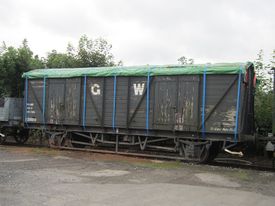GWR 112889 Mink 'G' Covered Goods Van
| GWR 112889 Mink 'G' Covered Goods Van | |
|---|---|
 GWR 112889 Mink 'G' Covered Goods Van | |
| Built By | GWR Swindon |
| Status | 1931 |
| Number | 112889 |
| History | |
| Built | 1931 |
| Diagram | V22 |
| Lot | 1067 |
| Type | 4-w ventilated van |
| Capacity | 20 tons |
| Telegraphic code | MINK G |
| 1993 | Arrived on the SVR |
GWR 112889 is a MINK G Covered Goods Van.
Section V of the GWR wagon Diagram book included covered goods wagons and grain wagons (GRANOs). Covered goods wagons, later called 'vans', were given the telegraphic code MINK. The majority of short wheelbase goods vans such as the MINK A had a length of 16ft over the headstocks and a 10-ton or 12-ton capacity, although the individual loads they carried rarely made use of this, the average being around 3.5 tons. A limited number of longer wheelbase vans were also built concurrently with these, including the MINK B and MINK C at 21ft in length and MINK D at 28ft 6in in length, although almost all of these had the same 10 or 12-ton capacity.[note 1]
In a bid to improve economy by introducing higher capacity stock, the GWR built a one-off batch of 100 MINK G covered goods wagons in 1930-31 to Diagram V22. These had a 19ft 6in wheelbase and a length of 30ft over the headstocks, giving a 20-ton rated capacity,[1] the largest 4-wheel goods vans built.[2] They were fitted with Instanter couplings rather than screw couplings although the latter may originally have been considered during their design (an entry in the GWR Lot book states "Instanter decided by Mr Collett 22 October 1930"). Due to their length, they also had large-headed self-contained buffers to guard against buffer locking, the van being capable of negotiating curves as tight as 2 chains radius.[1]They were used to transport consolidated batches of loads from goods depots on overnight shuttles[2].
Service and preservation[edit | edit source]
112889 was built at Swindon in 1931 to Diagram V22, Lot 1067.[1] BR Rolling Stock records confirm that it was condemned on 1 May 1964 and written off (but not marked as disposed) in December 1971. It continued in use for many years after that time as a P.W. Department stores van at Thirsk in Yorkshire, although it appears never to have been allocated an Internal User number, presumably because it had already been written off. Several other MINK Gs were also located at Thirsk, where they could be seen from passing ECML trains. The identity of the others is the subject of an RCTS article 'Mystery of the Thirsk GWR Mink G’s, although by 1980 112889 was the only one remaining.[3][2]
In later years it was identified as a possible target for preservation; Steve Peplow later reported in SVR News that "For years, people have been writing and telephoning, saying "why don't the SVR buy that wagon at Thirsk?" The simple answer was always "because it's not for sale!"." It was eventually acquired by The GWR 813 Preservation Fund in 1993, arriving on the SVR on 21 May 1993.[4]
Restoration at Bewdley began in summer 1994. It was initially thought that it would require a complete new roof and replacement of about half the body planks, together with door repairs and attention to the springs.[4] In the event, only one roof plank required replacement with other loose planks being re-secured, followed by complete re-canvassing. The canvas was fitted during the last weekend before Christmas; the process of painting it with a paint/linseed oil mixture then taking a considerable time as each coat took over a week to dry at that time of the year. The body planks were also in better condition than first thought, with only two side planks and one end being replaced. By spring 1995 the bodywork repairs were complete and the wagon had been repainted into GWR livery. The repaint included the wording "When empty return to Morris Cowley".[note 2] After leaving the Goods shed, final attention was given to the vacuum brakes and springs.[5]
112889 was still in use in September 2004 when in photographed in a Demonstration Goods Train at that year's Autumn Steam Gala. However by November 2009 it had been stored in Bewdley Down Yard awaiting an overhaul.
On 7 June 2024, as part of a major shunt of the yard, 112889 was moved from its position of many years at the end of the 'car park' siding to a position opposite the goods shed in preparation for a major overhaul by members of the LNER Carriage Group. In subsequent weeks over a tonne of wagon components, which had been stored in the vehicle for many years, were removed to allow repairs to be made to the floor.
See also[edit | edit source]
Notes[edit | edit source]
- ↑ The first 6 MINK Bs had an unusually high 18-ton capacity.
- ↑ It is not recorded whether this version of the wording would have been carried or whether 112889 was associated with Morris Cowley in service. Atkins et al notes that the original wording when built took the form of either 'To work between … & …', 'Load to …' or 'Return empty to …'. 'Return to …' became common after 1932 and after 1936 it was often 'Empty to Avonmouth'.